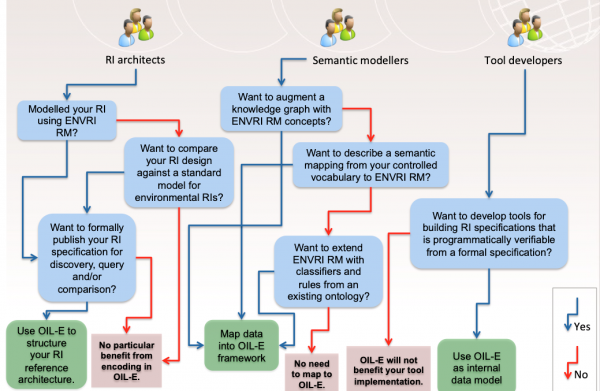A2. Open Information Linking for Environmental science research infrastructures
The attributes marked with a * are confidential and should not be disclosed outside the service provider.
| Service overview | |||||||||||||||||||||
| Service name | Open Information Linking for Environmental science research infrastructures (OIL-E) | ||||||||||||||||||||
| Service area | data | ||||||||||||||||||||
| Service phase | alpha | ||||||||||||||||||||
| Service description | OIL-E is a developing framework for addressing the semantic linking requirements of environmental science e-RIs. Specifically, it is intended to provide a machine-readable bridge between the ENVRI Reference Model and other concept models related to research infrastructure, architecture and scientific (meta)data. | ||||||||||||||||||||
| Customer group | RI data engineers/architects | ||||||||||||||||||||
| User group | Data-driven researchers | ||||||||||||||||||||
| Value | OIL-E is intended to provide technical and methodological guidance for the linking of different controlled vocabularies in order to help the construction of cross-cutting services. | ||||||||||||||||||||
| Tagline | Open linking between environmental science RI reference modelling and controlled vocabularies. | ||||||||||||||||||||
| Features |
| ||||||||||||||||||||
| Service options |
| ||||||||||||||||||||
| Access policies | Wide access | ||||||||||||||||||||
| Service management information | |||||||||||||||||||||
| Service owner * | Paul Martin | ||||||||||||||||||||
| Contact (internal) * | p.w.martin@uva.nl | ||||||||||||||||||||
| Contact (public) | |||||||||||||||||||||
| Request workflow * | 
| ||||||||||||||||||||
| Service request list |
| ||||||||||||||||||||
| Terms of use | |||||||||||||||||||||
| SLA(s) | |||||||||||||||||||||
| Other agreements | |||||||||||||||||||||
| Support unit | email support: Paul Martin (p.w.martin@uva.nl), Zhiming Zhao (z.zhao@uva.nl)
open for new test data and test queries | ||||||||||||||||||||
| User manual | online accessible documentation via http://www.oil-e.net/. | ||||||||||||||||||||
| Service architecture | |||||||||||||||||||||
| Service components | TRL3–4,development on-going.
| ||||||||||||||||||||
| Finances & resources | |||||||||||||||||||||
| Payment model(s) | Free | ||||||||||||||||||||
| Pricing | |||||||||||||||||||||
| Cost * |
The sustainability of the ENVRI RM ontology in OIL-E is partially tied to the sustainability of ENVRI RM itself. | ||||||||||||||||||||
| Revenue stream(s) * | |||||||||||||||||||||
| Action required |
[1] Technology Readiness Levels (TRL) are a method of estimating technology maturity of components during the acquisition process. For non-technical components, you can specify “n/a”. For technical components, you can select them based on the following definition from the EC:
- TRL 1 – basic principles observed
- TRL 2 – technology concept formulated
- TRL 3 – experimental proof of concept
- TRL 4 – technology validated in lab
- TRL 5 – technology validated in relevant environment (industrially relevant environment in the case of key enabling technologies)
- TRL 6 – technology demonstrated in relevant environment (industrially relevant environment in the case of key enabling technologies)
- TRL 7 – system prototype demonstration in operational environment
- TRL 8 – system complete and qualified
- TRL 9 – actual system proven in operational environment (competitive manufacturing in the case of key enabling technologies)